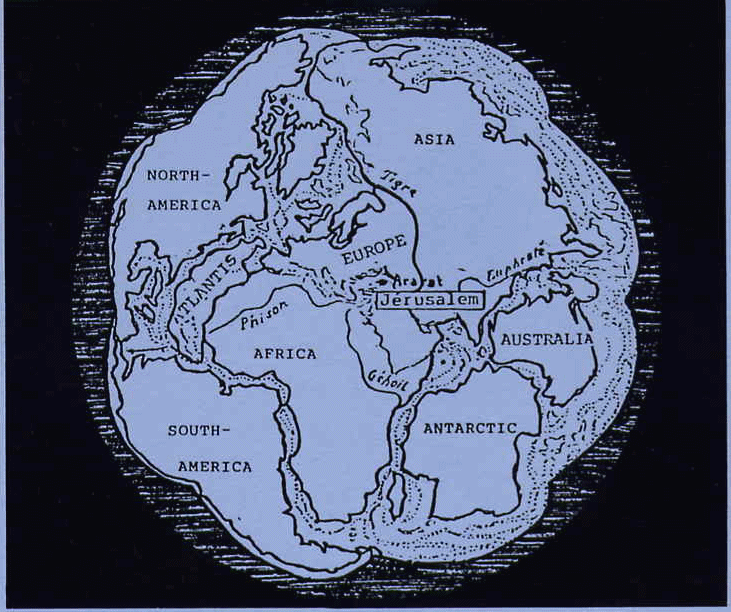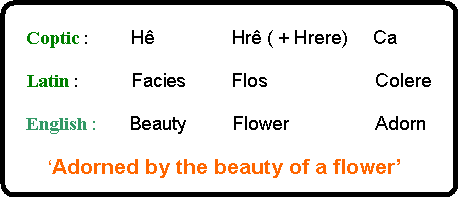

CREATION SCIENCE MOVEMENT
PAMPHLET 246
AUTHOR: Peter Wilder.
Divine Geography
The Reconstitution of the Primitive Terrestrial Spherric Cap
 Can geography be divine? By definition geography is a science of
the Earth's form and features. and is in consequence a highly material science.
Of all the sciences, geography would appear to be the least involved in any
direct relationship with the divine. The Earth was created by God, yes, but
after that we are left with just the materiality of the created act. At least,
this appears to be the reasoning of most Christian geographers, not only to-day,
but also in the past.
Can geography be divine? By definition geography is a science of
the Earth's form and features. and is in consequence a highly material science.
Of all the sciences, geography would appear to be the least involved in any
direct relationship with the divine. The Earth was created by God, yes, but
after that we are left with just the materiality of the created act. At least,
this appears to be the reasoning of most Christian geographers, not only to-day,
but also in the past.
The researches of Fernard Crombette throw quite a new light on the situation. He was unable to reconcile himself with the fact that statements in the Bible regarding the Earth might be inaccurate. In the first chapter of his book of the Bible it is written: "Let the waters under the heavens be gathered together into one place, and let the dry land appear". [Genesis 1:9]
There is no ambiguity here, yet the disposition of the continents as we see them to-day does not support this statement. Far from being gathered together in one place, the waters everywhere cut one landmass off from another. Then there is the intriguing statement in the Psalms, "Yet God my King is from of old, working Salvation in the midst of the Earth" [Psalm 73:12], The centre of midst of the Earth was by tradition considered to be Jerusalem. Crombette's approach was different from his predecessors', in that he considered the Bible was right, but that insufficient information was yet available to harmonise it with science. He was perfectly aware of the work of Alfred Wegener, whose book in 1915 argued for a slow breaking up of the original land mass into pieces that drifted apart over hundreds of millions of years to form the continents we see to-day. Wegener died in 1930 believing his theory of slow continental drift had been confirmed by a number of experiments, but it was discovered shortly after his death that his belief was an illusion. The results of a study by Nicolas Stoyco handed to the French academy of Science demonstrated that Wegner's conclusions are unsupported by fact.
Since 1960, new theories of continental drift have been developed in conjunction with plate tectonics and sea floor spreading, but there is still a fair degree of scepticism on the subject. "Meyerhoff, Jeffries, the Russian geophysicists and other outstanding Earth scientists consider continental drift as geophisically impossible". [Scientific Creationism - Morris p.128]
There is of course some common ground with that part of Wegener's basic premise of an original continent, and the statement in the Scriptures. Crombette carefully studied Wegner's proposals for relating the continents to each other, and although he found some unacceptable, he nevertheless found some compatible with the idea of a sudden break-up of land. After all there are indications that prior to the Deluge there was only one race of people, speaking one language and perhaps living on one continent. Writing discovered in the Indus valley, which could well date from pre-diluvial times, is made up of characters very similar to those found in inscriptions in Easter Island. Yet these two places are at opposite sides of the globe. If a civilisation had existed with the same written language, it would be reasonable to assume that it shared the same land. It demands a considerable stretch of the imagination to accept that the Indus Valley and Easter Island were originally part of the same land mass. But if they were, what happened to push them so far apart? What kind of cataclysm could have achieved the separation, and when might it have occurred? If civilised man once lived on a super-continent 'Pangea'. surrounded by a super-ocean 'Panthalassa', then in whatever terms you recon, the dislocation of the land must have taken place relatively recently, i.e. certainly not more than a few thousand years ago.
So if there was a 'Pangea', and there must have been, because the bible does not make mistakes, then what caused it to break up, and what was the mechanism? Crombette considered that the only event recorded in the Bible capable of producing the enormous forces necessary to crack up the original block and drive the pieces to there present positions was Noah's Flood. The hydraulic forces, coupled with the techtonic activity unleashed by a world wide flood, might well be sufficient to change the face of the Earth. If this was so, Crombette could set to work. His view was that what had come apart physically could be put back together intellectually. All the parts were there, if not above the water then below the water. It was just a question of finding them and putting the puzzle together. So this is what he set out to do, to reconstruct, on paper, the Earth as it was before the catastrophe. He would have an enormous advantage over Wegener and the others, because he knew where to start. The Scriptures are quite emphatic, "God is from of old, working Salvation in the midst of the Earth". As Jesus Christ our Lord died to save us in Jerusalem, then it is around this point, he reasoned, that the continents, islands and banks could be grouped. At least this, on the face of it and notwithstanding appearances to the contrary, appeared to him to be the case.
Still looking to the Bible for inspiration, he re-examined the Genesis passage. "And God made the firmament and separated the waters which were under the firmament from the waters which were above the firmament". He had already been struck by the fact that the continents and islands were generally hemmed by a sort of bedrock sloping gently to about 200 metres, then more sharply to an average of 2,000 metres: the steep abyssal slopes going down to the ocean depths beneath. Could it be that the word 'separated' in the Genesis verse meant 'halved'? If half of the waters were originally "above the firmament" and corresponded with Kant's hypothesis of an aqueous ring, similar to Saturn's rings, surrounding the Earth, then the 2000 metre bedrock level would have a special significance! Since the average depth of the oceans and seas is 4000 metres at the present time, then by taking half of the water as being above the firmament prior to the Flood, you arrive at an average pre-Flood, sea depth of 2000 metres. The sloping sides of the continents or the continental shelf, would have, therefore, been above the water line. Crombette decided to put the theory to the test. He scoured the maritime museums of the world for bathymetric maps at minus 2000 metres. The results of his search confirmed his reasoning. The continents and islands, which if put together at sea level made a very imperfect fit, apart from the notable exceptions such as Antarctica and Australia, if moved to the right positions, joined together almost perfectly at 2,000 metres below sea level. It was just a question of time, therefore, to complete the task. The final reconstruction provides a single unit of land with eight symmetrical scalloped sides. It is flower-shape with Jerusalem at its centre.
In his original work "Essai de Geographie Divine", Crombette shows how he analysed the works, reports, results of explorations and the studies of different experts, to arrive at a logical explanation of how the 'drift' of the continents really took place. A group of scientists have formed an organisation called CESHE [Cercle Scientifique Historique] to continue and propagate Crombette's work, and it is through them that a summary of his divine geography has been made available in the English language. entitled "General Views on F.Crombette's Essay on Divine Geography". and this is now obtainable through the Creation Science Movement [C.S.M.]. It contains 95 maps and although it does not attempt to reproduce the wealth of detail contained in the original work, it nevertheless provides all the principal features of the reconstruction.
Fernand Crombette died in 1970, and his dedication to demonstrating the scientific and historical accuracy of the various happenings in the Bible led him to undertake a number of daunting projects. His most important was the discovery of a method of translating Egyptian and other hieroglyphics as well as ancient Hebrew into the Coptic language. As a result of this he undertook the incredible task of retranslating the entire history of ancient Egypt into the Coptic language. He also did the same thing for the history of Crete and the Hittite nation. The result was that he was able to establish a direct link between the children and grandchildren of Noah and the foundation of the Egyptian nation, and a correspondence between the historical events recounted in the Bible and those recorded in the hieroglyphic inscriptions. His method which produces much more detail than previous methods has cast new light on some of the misunderstandings of the early chapters of Genesis. He has translated the first eleven chapters from Hebrew into Coptic and a number of details emerge which confirm the creation events and the Noachian Flood. One example is Crombette's translation into Coptic of the Hebrew word for the dry land....Herec.

This
is the true name of the dry part of the Earth created for man! It corresponds to
the harmonious festoon shape that Crombette has reconstructed, and the name
given to it comes from God Himself!
